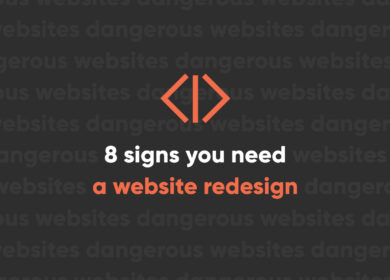
Why Is My Bounce Rate So High?

A high bounce rate means your website is bad, right? Not necessarily. When looking at your bounce rate, there are a lot of factors to consider. In fact, contrary to the popular "I came, I saw, I puked" definition of bounce rate, a bounce isn’t always an unsuccessful visit. As with any data, the bounce requires a bit more thinking than just looking at a number.
What Exactly Is Bounce Rate?
Before we discuss the various reasons for a high bounce rate, let’s make sure we have a clear understanding of what bounce rate is. In the most traditional terms (and according to Google Analytics), a bounce is a single-page visit to your website. However, in reality, Google Analytics only records a bounce when a session involves a single interaction. It’s possible for a single-page visit not to be a bounce if other activity occurs, such as a video view, form submission, or even scrolling. This all depends on the type of event tracking you have set up on your website.
In other words, a bounce occurs when a visitor lands on a page on your site and leaves without doing anything else recognized by analytics.

The bounce rate is the percentage of bounces compared to all sessions during a given time period. If you have 100 sessions and 40 of them were bounces, then your bounce rate is 40%. Pretty simple, right? Okay, then let’s move on.
What’s a Good Bounce Rate?
Now that we have the definition out of the way, you’re probably wondering what your bounce rate should be. This is a much more difficult question and depends a lot on your industry and the purpose of your website. A good eCommerce bounce rate and a good blog bounce rate are two very different numbers.
There’s no universal agreement upon the standards for a good bounce rate. If your site is generally performing well (driving quality leads and sales), then bounce rate probably shouldn’t be your top concern. But that doesn’t mean bounce rate is a useless metric. As with just about anything in your analytics, it depends how you use it.
The main problem is that bounce rate on its own doesn’t tell you much. Even comparing your bounce rate to industry benchmarks might be unproductive. Rather than simply looking at your bounce rate as a whole, a more productive approach is to compare your bounce rate across different segments. This will help you identify areas where you might be able to improve your website and your marketing efforts. After all, the data on its own can’t ever tell you why your bounce rate is so high.
Depends on the Entry Page
Looking at your bounce rate by entry page can help you identify which pages perform well—and which ones don’t. With this data, you can redesign certain pages or adjust your marketing strategies to make sure you are sending people to pages that do perform well. For example, if one of your AdWords landing pages has a really high bounce rate and very few conversions, you probably want to choose a different destination URL.
Of course, just because a particular entry page has a high bounce rate doesn’t mean it’s a bad page. For example, a blog post (like this one) will typically have a higher bounce rate than your site’s core pages. That doesn’t mean these bounces are all unsuccessful visits. Someone could read that blog post and leave without visiting any other pages on your site. Maybe they’ll even copy and paste the link on social media. As a single-page visit, this will still register as a bounce (there are some ways you can implement your analytics to help you gain more insight into these visits, but that’s a conversation for another day).
The same is true of a contact or location page. Someone might land on your contact page because they’re looking for your phone number or address. Again, this could result in a bounce that isn’t necessarily a failure. Lumping all bounces together and calling them failed visits is a horrible way of looking at your data. But if 75% of your visitors are bouncing from the home page, then maybe you need to consider making some changes.
Depends on Device or Browser
Your website’s bounce rate may vary greatly by device type or browser. Breaking the data down by technology can give you more insight about the usability of your site. For example, a high mobile bounce rate might tell you that your website doesn’t work very well on mobile devices. Or maybe your site looks and works great on most devices, but people with iPhones tend to bounce. When you notice one particular device has a high bounce rate, this is a sign that something may be wrong.
The same is true of browser type. Are all visits from Internet Explorer 8 resulting in a bounce? While we’d like to think no one still uses this ancient and problematic browser, plenty of people still do. When you see a high bounce rate on a particular browser, you’ll want to dig into that problem by testing your website on that browser. And maybe it’s not even a browser specific problem. Maybe the types of people who use IE8 are just more likely to bounce from your site. When looking at bounce rate for any segment, you obviously don’t want to jump to conclusions without doing adequate research and performance analysis first.
Be careful about overreacting to a higher mobile bounce rate though. Remember, people on mobile devices tend to be on the go. Therefore, they may inherently be more likely to visit just a single page on your website. Oh, and don’t take too much stock in the bounce rate without also considering the size of the data set. If you only have three visitors from a specific device, then your 100% bounce rate means pretty much nothing.
Depends on Referral Source (and the Intent of the User)
Not all referrals are equal. Traffic you get from social media might be much more likely to bounce. Think of it this way: someone is browsing through Facebook, haphazardly liking their friends’ statuses and commenting on various cat videos. A link to your site pops up in their feed (either through an ad or because someone shared it). Intrigued, the person clicks the link and lands on your site. How long do you think that person will be on your site? Remember, this is a person who was engrossed in the all-important task of browsing through social media.

The same could be true of any referring website. Someone who gets to your site through another site might be less engaged. They may have happened upon your site because of curiosity, not because of intent. The intent of the visitor is a huge factor in bounce rate.
In theory, direct traffic and search traffic should have the lowest bounce rates, but this isn’t always true either. Again, a lot of this boils down to the intent of your user. Think of these search result scenarios:
- A searcher is looking for a specific product just for price comparison purposes
- A searcher is looking for the answer to a specific question
- A searcher is looking for a very general type of product or service
In all of the cases above, a bounce might be inevitable regardless of how amazing your site is. The first searcher lands on your product page and finds out the price. Bounce. The second searcher lands on an informational page and gets the answer. Bounce. The third searcher lands on your page and sees you don’t have the product or service he or she wants. Bounce.
Searcher intent will have a huge impact on your bounce rate. Direct traffic is no better. Someone who types in your URL and comes directly to your site might just be looking for a phone number. Or maybe they want to see if you have any new blog posts up. Add in the fact that direct traffic these days is a bit of a mystery, and now you’re looking at an even more difficult set of data to analyze.
So Why Is My Bounce Rate So High?
If your bounce rate seems excessively high across the board, then there are two likely culprits (beyond the reasons we’ve already discussed):
1. Your website isn’t providing a good user experience
2. Your website isn’t meeting the expectations of your visitors
To solve these problems, you might implement A/B testing. Test different calls to action, different content, different layouts, different navigation. You can also work on better targeting in your marketing efforts. Make sure you are bringing the right people to the right pages on your site. Or maybe you just need a brand new website.
Conclusion
Your bounce rate holds a lot of secrets. Unfortunately, you may not be able to unravel all those secrets no matter how hard you work. However, with the right analysis, you might be able to determine ways to improve your site—or just specific portions of your site—in order to reduce your bounce rate.
Remember though that not every visitor is necessarily a potential customer. No matter how hard you try, you will never have a 0% bounce rate. The important thing is to make your site as user-friendly as possible so you can drive more leads or sales. Chasing some impossibly low bounce rate should never be your primary website goal. At least not until you have every other problem solved.
This post is part of Internet Marketing Mysteries, a weekly column addressing actual client questions related to SEO, analytics, website best practices, and any other topic connected to internet marketing. Have a question you’d like to see tackled in a future post? Let us know in the comments.

Nate Tower
Nate Tower is the President of Perrill and has over 12 years of marketing and sales experience. During his career in digital marketing, Nate has demonstrated exceptional skills in strategic planning, creative ideation and execution. Nate's academic background includes a B.A. with a double major in English Language and Literature, Secondary Education, and a minor in Creative Writing from Washington University. He further expanded his expertise by completing the MBA Essentials program at Carlson Executive Education, University of Minnesota.
Nate holds multiple certifications from HubSpot and Google including Sales Hub Enterprise Implementation, Google Analytics for Power Users and Google Analytics 4. His unique blend of creative and analytical skills positions him as a leader in both the marketing and creative worlds. This, coupled with his passion for learning and educating, lends him the ability to make the complex accessible and the perplexing clear.




